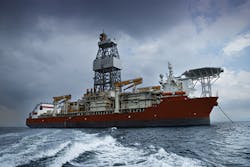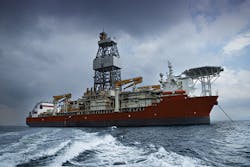Financing offshore assets
Market conditions today contrast sharply from those of just a few months ago
Martin Toulouse and Peter Glenn, Baker Botts LLP, New York, NY
Sponsors looking to finance assets such as drillships, traditional rigs, spars, floating production semi-submersibles, or other offshore exploration and production installations destined for operations in the Gulf of Mexico face a starkly different environment today than even just a few months ago. In particular, the risk/reward profile of these assets presents a unique suite of considerations for both owners and potential financiers.
Offshore exploration and production is typically more expensive and riskier than onshore projects, especially given the shift towards deep and ultra-deepwater exploration, which influences the financing terms available to sponsors. In 2013 and the beginning of 2014, we saw energy companies committing more and more resources to E&P projects as oil and natural gas prices were experiencing sustained highs, spurring increased orders for offshore installations to sustain the forecasted boom.
Challenges began to emerge as oil prices peaked in the summer of 2014 before beginning a serious slide to less than half of the top prices by the end of the year, and it is not clear when the current price pressures will be alleviated. The effects of the current market conditions may rule out certain options to finance offshore assets, but there remain a number of possibilities for owners looking to complete deals in 2015 and beyond.
Traditionally, there have been a number of methods to finance offshore assets available to their owners. Many of the larger and stronger companies simply chose to finance their entire fleet on-balance sheet. With the right mix of assets, contract backlog, and contract tenor, such companies were able use conventional corporate bank financings, debt capital markets, and in some cases, favorable term loan B structures to finance their operations and the development of new assets.
Drillships, FPSOs, and other offshore assets have also long been financed on a stand-alone basis using special purpose vehicles. In many parts of the world, long-term contracts and charters for drillships, FPSOs, and similar assets make them particularly suitable for vessel financing arrangements provided by commercial bank lenders. Relying in large part on the creditworthiness of the charterer, lenders will fund the construction, development, and operation of the vessel.
Depending on the sourcing of materials used in the project, export credit agencies may be in a position to finance a portion of the project as well. However, many such vessels operating in the Gulf of Mexico rely upon short-term contracts, which can complicate financing efforts for owners looking to operate in that region.
In addition to commercial banks, the debt capital markets and institutional private placement market have been tapped to finance individual offshore units. Brazil has seen the most activity in that respect. For example, in May 2013, Odebrecht Offshore Drilling Finance Limited successfully sold approximately $1.8 billion in project bonds, rated Baa3, with a roughly nine-year maturity in a Regulation 144A/S offering, secured by mortgages over two drillships and a semi-submersible rig, and the revenues generated by each vessel's respective long-term charter.
Each drillship was under charter for 10 years, and the rig was under charter for seven years, which terminated four years prior to the maturity of the bonds, and all were in operation off the coast of Brazil. However, to partially cover the re-contracting risk created by the gap between the termination of charters and maturity of the debt, the bonds featured two cash sweeps: the first beginning as early as 12 months prior to the termination of each charter and the second beginning three years and 10 months prior to maturity.
More recently, a subsidiary of SBM Offshore NV completed a $450 million offering of seven-year senior secured notes in an institutional private placement to support its natural gas production center located in the Deep Panuke field off the coast of Nova Scotia, Canada. The project operates under a charter-party contract with Encana for an initial term of eight years. Fitch assigned a BBB- rating to the bonds, citing the charter's achievable performance requirements, the pass-through of all operational costs to Encana, and the lack of exposure to resource risk.
Bonds can provide a welcome diversification of financing sources to project owners, but to the extent issued in reliance on a single charter party, may be subject to a ratings downgrade and associated consequences in the case of an unexpected deterioration of the counterparty's credit quality, especially when decreased demand globally makes it more challenging to re-charter the vessel. For example the difficulties encountered by the OSX group of companies in Brazil led to restructuring negotiations with holders of $500 million in project bonds issued to finance the construction of an FPSO vessel destined for operations in the Campos Basin. Similarly, some of the bonds issued to finance FPSOs chartered to Petrobras were subject to recent ratings downgrades.
While traditional vessel financing structures, whether in the bank or bond markets, are often based on long-term charter arrangements that entail fixed lease payments from strong counterparties, lenders may be willing to assume some resource risk in certain circumstances. To the extent the revenues to be received by the owner of an offshore unit being financed are subject to volume, price, or development risk with respect to the associated resources, the lenders' credit analysis becomes more complicated. Lenders must consider more than the counterparty's credit quality and the terms of the charter, and must assess whether market forces, operational conditions, or other risks could result in a curtailment of production or otherwise affect revenues.
However, with proper structuring and combining traditional vessel financing with project finance and reserve-based lending skills, innovative financing arrangements that incorporate some resource risk can be workable so long as the projected cash flows are sufficient to support the debt. Structures of this type alleviate the need to secure a long-term charter arrangement from an investment grade counterparty and, therefore, can present an interesting option for sponsors wishing to finance individual assets on a standalone basis.
Current market conditions
The drop in oil and natural gas prices has not only affected projects under way, but has reverberated across the sector in a wider fashion. E&P companies have announced decreased exploration budgets as the incentive to drill new wells and explore new fields has diminished. As a result, new orders can be expected to decline to some extent or be delayed. Further exacerbating these issues is the oversupply of many offshore assets, particularly in certain segments.
While energy prices were high, there was a rush to construct newbuild vessels, platforms, and rigs to service all of the fields projected to come online in the coming years. But, as of the end of February 2015, IHS estimated the percentage of jackups, semi-submersibles, and drillships under contract in the Gulf of Mexico at 79%, down from 95.53% last year at the same time. This has put pressure on day rates as price competition has set in and dampened the prospects of re-contracting assets as they roll off previous charters. According to various industry sources, day rates have started to decrease, in some cases materially, with more rigs and drillships set to come into the market over the next 12 to 18 months.
In the Gulf of Mexico, pricing pressures are expected to be particularly significant with respect to jackups, given the large number of uncontracted newbuild jackups scheduled for delivery in the near future. In the circumstances, if the price environment continues to be challenging, it would not be surprising to see some older units being cold-stacked or scrapped earlier than originally anticipated.
However, the market outlook is not all bleak as the current pressure for offshore units is at least partially offset by a number of factors. The existing fleet is aging and there will be a need to replace obsolete equipment in the coming years. The technological requirements of some of the newer plays in ultra-deep waters will require either newbuilds or refurbishment of existing assets. And a significant unknown is the level of demand that could result from the newly opened Mexican regions of the Gulf of Mexico, all of which could act to partially counteract the market demand drag and oversupply.
Given the current uncertainty in the market, what options remain for companies wishing to finance their offshore projects? Stronger companies will no doubt continue accessing the conventional bank and capital markets to obtain necessary capital, though potentially on less favorable terms. But for the smaller owners of offshore assets, access to credit could be more challenging, at least in the short run.
A particular company's ability to get financing will depend in part on the nature and age of its fleet, its geographic focus, and overall contract backlog. With respect to individual assets, the availability of a longer-term charter arrangement with a strong counterparty will continue to be a key factor in determining whether standalone financing can be considered.
While access to traditional financing sources may be more challenging for some industry participants, a notable development in the recent past has been the amount of capital raised by alternative investors to focus on the energy industry. Private equity firms such as Blackstone, KKR, and Apollo created funds to acquire assets and make investments in companies operating across the energy value chain and are actively looking for opportunities to deploy capital. Most recently, Blackstone announced the closing of its second energy-focused private equity fund, with total commitments of $4.5 billion.
Energy funds and other alternative financing sources may be willing to provide additional capital to asset owners to refinance upcoming maturities, bridge current capital needs or help develop individual systems. In addition, as was seen in recent transactions consummated onshore, hedge funds and private equity funds may be willing to provide financing for E&P activities through working interest or royalty interest investments, such as overriding royalty interests or volumetric production payments. Such additional financing could in turn help support the construction and financing of related offshore production infrastructure.
The decrease in commodity prices has deeply affected the energy sector and the tools energy companies possess to acquire the capital required to proceed with their desired projects. In the short and medium term, many projects are expected to be delayed or cancelled. However, despite the current market prices and supply concerns with respect to offshore units, many remain optimistic about the long-term prospects for development in the Gulf of Mexico, and capital should remain available to sound projects and companies even during the downturn.
About the authors
Martin Toulouse is a partner in the Baker Botts New York office. He represents financial institutions and corporations in all areas of private finance, with a particular emphasis on complex acquisition, project and other structured financing transactions in the energy and infrastructure sectors. A significant portion of his practice includes cross-border transactions.
Peter Glenn an associate in the Global Projects Practice at Baker Botts where he focuses on the development and finance of infrastructure projects, both in the United States and internationally.



